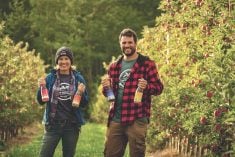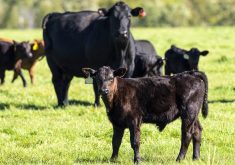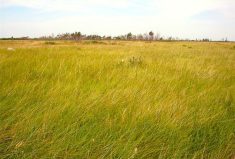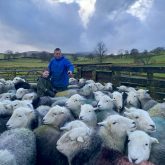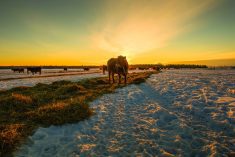The Tantramar Marsh near Sackville, New Brunswick, is a rich biodiversity zone and serves as an important flyway for North American birds. It is also home to the Tantramar Community Pasture, 1,685 acres on Crown land established in 1961 to provide cattle producers limited land to pasture their livestock and help keep costs low.
About 600 of the acres are productive pastureland. While pasture manager Matt Beal says the rest is marginal, the 400 head currently on the pasture have free range of it all.
“Access to the pasture on the Crown land allows cattle producers the opportunity to increase their carrying capacity and grow the beef herd throughout the Maritimes,” Beal says. “Our agenda is to increase the carrying capacity of the pasture, improve its productivity and hopefully leave it in better shape than the previous year. We also try to do real-life projects that producers can take back to their own operations and try.”
Read Also
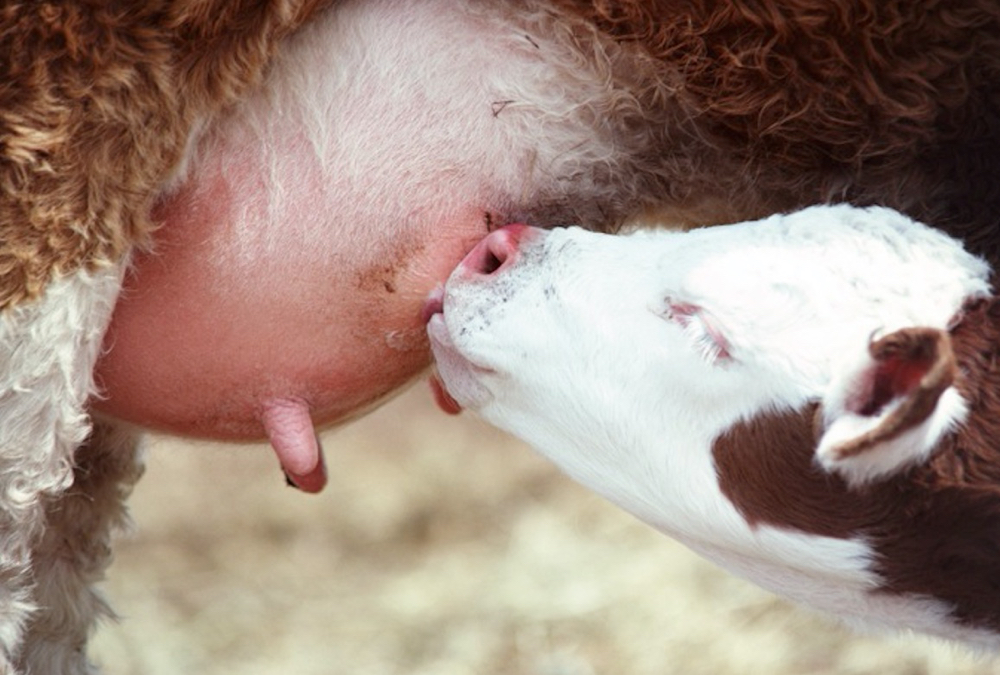
Veterinary know-how on the farm
If you’re a livestock farmer, you’ve likely faced one of the most frustrating situations on the farm: a sick or…
To this end, the New Brunswick Soil and Crop Improvement Association (NBSCIA) is leading a large, collaborative project on the Tantramar Community Pasture. It began in 2018 as part of the Canadian Forage and Grassland Association’s (CFGA) Agricultural Greenhouse Gas Pro- gram (AGGP) project and aims to demonstrate the carbon being sequestered by actively managed grasslands and the risk to those carbon stores should these grasslands be converted to annual cropping. The project also involves testing the avoided conversion of grasslands protocol prototype which could someday lead to assign- ing carbon credits to actively managed grasslands to be sold in the carbon market.
Benefits of rotational grazing
A key component of the project is the installation of cross fencing to better use the grasslands. The cross fences are funded partly through the AGGP and also with the assistance of the New Brunswick Department of Agriculture, Aquaculture and Fisheries through the Canadian Agriculture Partnership. The NBSCIA hopes to use the cross fences to demonstrate the benefits of rotational grazing not only on carbon sequestration but also on pasture yield, quality and species mix.
“The Tantramar Community Pasture project falls in line with NBSCIA’s mission as it allows us to drive both productivity and sustainability in the beef industry,” says NBSCIA agro-environmental agrologist Zoshia Fraser. “In the future, we hope the infrastructure being installed on the pasture will enable the site to develop into a regional hub for other research and demonstration projects.”

Camryn Trenholm is the project technician for the Tantramar Community Pasture Project. She brings two seasons of experience working in Nova Scotia at Agriculture and Agri-Food Canada’s Nappan Research Farm with research biologist John Duynisveld, whose main work is rotational grazing. Her role in the project is planning and executing the on-ground work, including creating the sampling schedule, taking samples, building paddocks, and when the paddocks needed to be subdivided, mapping and installing the fencing.
“The Tantramar Community Pasture is the ideal place to conduct management trials because it has had limited management since it was established; it is the bare bones of what a pasture is,” Trenholm says, explaining the goal with the rotational grazing is to improve the forage quality of the pasture.
“What we want to do is shift to more legume and good-quality forage grass species rather than some of the non-essential plants or weeds we currently see in the pasture.”
Demonstration project
This ties into another goal of the project: To show local producers that rotational grazing is a viable management technique for them to use in their pastures.
“Rotational grazing is a reliable way to improve forage quality with a short-term investment,” Trenholm says. “You have the fencing cost in the beginning, but once you have the fencing in, it’s an easy way to improve forage and when you improve forage quality, you improve cow quality, which improves your benefits overall.”
Since the project is only in its first season, Trenholm does not yet have data to show forage improvement in the pasture. However, anecdotally, as other community pastures in the region had to send cows back to their farms because of the region’s drought conditions, the 400 head on the Tantramar Community Pasture were still grazing there in late August. And, if the project is as successful as they hope, they expect they will be able to double the number of cattle the pasture can support.
The season has been a learning experience. “We’ve gained a lot of knowledge on how this is going to work and the best way to do it,” Trenholm says. “It’s a good example of some of the challenges you need to take into account in the planning stages of rotational grazing.”
For example, producers should always consider water access for cattle when designing their fencing system. Next year, they will have water systems built, thanks to a partnership with Ducks Unlimited Canada (DUC) that will see DUC invest in water systems to re-establish wetlands on the pasture.
CFGA executive director Cedric MacLeod says this partnership with DUC will serve two functions, including creating biodiversity hot spots as well as providing active, fresh, clean water access for the cattle.
“Through this project’s cross fencing work, we are now moving cattle on the pasture, between paddocks, to where the water is,” MacLeod says. “Now that we have this strategic fencing infrastructure, DUC is going to come in and intercept that with their water systems.
“Then we won’t need a water system in every paddock; we’ll only need one for every two since we’ve designed these fencing systems to intercept with DUC wetlands. That will make us resource-efficient, production-efficient, biodiversity-efficient and grassland-efficient, and these are all coming together under this one project.”
Analyzing soil carbon
Research work led by Dr. David Burton at Dalhousie University in Nova Scotia is providing additional evidence to support the project’s goals. Burton’s group is assessing soil health, including soil carbon content, in the Maritimes, including at the Tantramar Community Pasture. He and his team took samples from the pasture two years ago, analyzed them and are now assembling the results, which they expect to release in the spring of 2021.
“Broadly, we’re trying to get baseline data on soil health,” Burton says. “Specifically, we’re looking at the relationship between soil health and land management. What we are finding is that systems that disturb the soil less and keep soils covered are the best practices to build soil health. Pastures are a model system of both of those.”
That’s because they provide the four best practices needed for healthy soil: limited disturbance, increased plant cover, increased return of organic matter and increased plant diversity, including legumes.
“When you have cattle on the pasture, their hooves do a little compressing, but when the cows leave, the plants still have actively growing roots,” Burton explains. “Depending on the strategy being used, for example, if using a rotation system and only cows grazed, the cattle leave the plants still growing. Cattle are also returning organic matter to the soil and mixing it in. That’s all good.”
Jason Wells, the livestock feed crop development specialist with New Brunswick’s Department of Agriculture, says it is well documented that rotational grazing can increase the carrying capacity of the land.
“It allows the pasture plants time to recover after being grazed so that they stay productive and persistent. It also allows pasture plants to develop a larger, healthier root system that can go deeper into the soil for water, thus improving its drought tolerance,” he says. “With our current dry spell, the project currently underway at the Tantramar Community Pasture is an excellent showpiece on drought tolerance as well as all the other benefits that rotational grazing has to offer.”
Moving forward
MacLeod is also interested in finding a way to measure the biodiversity on the pasture acreage and look at the impact grazing has on biodiversity. This fits in with the CFGA’s Nature Fund Project, which will see the development of online habitat and biodiversity management tools.
“One of the things we wanted to do was understand the impact of intensive grazing management on the overall biodiversity on the pasture,” MacLeod says. “Are we achieving good things for biodiversity as a whole? I believe very strongly that we are.”
MacLeod is currently connecting with biodiversity and conservation groups to discuss what can be done to monitor biodiversity. So while a primary objective of the project is to demonstrate the value of rotational grazing programs to all growers, not just community pasture growers, MacLeod says another objective is to continue to build bridges with the conservation community.
“When we can enhance cattle management areas, seize conservation opportunities and drive biodiversity enhancements all at the same time, those are the win-win-win scenarios everyone is ultimately seeking.”
This article was originally published in the October issue of the Forage & Grassland Guide.




